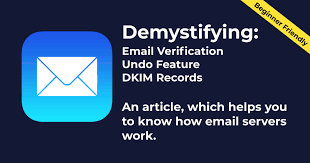In the ever-evolving landscape of digital communication and marketing, email remains a powerful tool. However, maintaining a clean and responsive email list is crucial for success. This is where email verification comes into play. In this comprehensive guide, we will unravel the mysteries of email verification, exploring its significance, processes, and why it's an indispensable part of any email marketing strategy.
Understanding Email Verification
Email verification is a process that ensures the validity and deliverability of an email address. It involves a series of checks and validations to verify whether an email address is legitimate, active, and capable of receiving emails. The primary goal of email verification is to improve email list quality, enhance deliverability, and minimize bounce rates.
The Email Verification Process
Email verification typically includes the following steps:
Syntax Check: This initial step verifies if the email address follows the correct syntax or format rules. It checks for common errors such as missing "@" symbols or extra spaces.
Domain Validation: After syntax validation, the system checks if the domain (the part after the "@" symbol) exists and has valid DNS records. This ensures that the domain is capable of receiving emails.
MX Record Check: The process confirms whether the domain has a functioning Mail Exchange (MX) record, indicating that it can receive emails. If the domain lacks an MX record, it's considered invalid.
Disposable Email Detection: Disposable or temporary email addresses are often used for spam or fraudulent purposes. Email verification tools can identify and flag such addresses, allowing you to exclude them from your list.
Role-Based Email Detection: Role-based email addresses (e.g., [email protected]) are often used for generic purposes. While they are not necessarily invalid, their use may vary depending on your email marketing goals.
Why Email Verification Matters
Now that we've demystified the email verification process, let's explore why it matters:
1. Improved Deliverability
Email verification significantly enhances your email deliverability rate. By ensuring that your emails reach legitimate and active addresses, you reduce the risk of bouncing emails, which can negatively impact your sender reputation.
2. Enhanced Sender Reputation
A clean email list contributes to a positive sender reputation. Email service providers (ESPs) like Gmail and Yahoo! consider sender reputation when deciding whether to deliver your emails to the inbox or spam folder. A high sender reputation leads to better inbox placement.
3. Cost Savings
Maintaining a large email list can be expensive. By regularly verifying and cleaning your list, you can reduce costs associated with sending emails to invalid or unresponsive addresses.
4. Compliance with Regulations
Email verification helps you comply with anti-spam regulations like the CAN-SPAM Act and GDPR. Sending emails to valid and consenting recipients ensures you meet legal requirements and avoid penalties.
5. Better Engagement
Emails sent to engaged and active subscribers are more likely to be opened and acted upon. Email verification helps you target the right audience, leading to higher engagement rates.
How Email Verification Works
Email verification can be performed using various methods, including manual checks, software, and third-party services. Some common email verification methods include:
Real-Time Verification: This method verifies email addresses in real-time during the signup process. Users receive immediate feedback on whether their email address is valid.
Batch Verification: In batch verification, you upload a list of email addresses, and the verification tool processes them all at once. It's an efficient way to clean up existing lists.
API Integration: Email verification services often offer APIs that integrate seamlessly with your email marketing platform, allowing you to verify email addresses automatically.
Frequently Asked Questions (FAQs)
Let's address some of the most commonly asked questions about email verification:
1. Is email verification necessary for small businesses?
Yes, email verification is valuable for businesses of all sizes. It helps maintain a clean email list, improve deliverability, and enhance engagement, which are crucial for the success of email marketing campaigns.
2. Can email verification prevent all bounce backs?
While email verification significantly reduces bounce rates, it may not prevent all bounce backs. Some bounces may occur due to temporary issues on the recipient's end, such as a full inbox.
3. How often should I verify my email list?
The frequency of email verification depends on the size and activity of your email list. It's recommended to verify your list regularly, especially before major email campaigns, to ensure optimal results.
4. Are there free email verification tools available?
Yes, some email verification tools offer free plans with limited features. However, for comprehensive and accurate verification, it's often advisable to invest in a reputable paid service.
In conclusion, email verification is a fundamental aspect of email marketing that should not be overlooked. By understanding its significance, the verification process, and the benefits it brings to your campaigns, you can harness the full potential of email communication and achieve better results in your marketing



